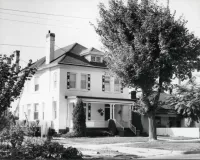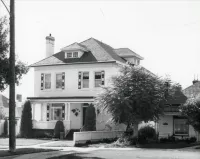Share what you know,
and discover more.
Share what you know,
and discover more.
May 21, 1979

-

- Charmaine Bantugan
National Register of Historic Places - Fortunate Anselmo House (Ronald L. Beers House)
Statement of Significant: The Anselmo house derives its significance, as the residence of Fortunato Anselmo, Italia n vice consul in Salt Lake City for forty-one years. Anselmo, as vice consul, served a vital and necessary role in the lives of Italian people in the states of Utah and Wyoming, as well as being of significance in the political, social, and civic environment of Salt Lake City. The house was originally built by Silas B, Wood, a carpenter, in 1903. Building registries indicate that a permit was issued May 9, 1903, for a nine-room residence with an estimated cost of $4,000. Wood was late r listed in city directories as a contractor, and in 1907 joined with prominent architect John A. Headlund to form Headlund and Wood, Architects, a partnership which lasted only until 1910. Oscar G. Hemenway and his wife Rebecca acquired the house in December 1905. Hemenway was head of Hemenway & Moser, Wholesale Cigars, located at 73 West 200 South, Salt Lake City. In April, 1908, Frank B. and Emma Zina Gawan purchased the property and resided there until 1920. Gawan served as the superintendent of P. J. Moran, contractor, who operated an asphalt paving plant on Canyon Road. The house became the residence of Fortunato and Anna Anselmo in 1920, and remained as such until 1950. I t was during this period that the house attained specific significance as the residence of Italy' s vice consul for Utah and Wyoming. Fortunato Anselmo was born October 1, 1883, in Grimaldi, Italy. He immigrated to the United States in the first decade of the Twentieth Century, settling with his sister in Pueblo, Colorado. While in Pueblo Anselmo found employment as a reporter f o r the Italian-American newspaper I1 Vindice, and also engaged I n mercantile interests. He moved to Salt Lake City i n 1911, and operated a wholesale Imported food business, F. Anselmo & Co. Fortunato had married Anna Pagano in Pueblo in 1909. Upon his residency in Utah he founded, in about 1912-1913, La Gazzetta Italian, quickly establishing himself as a spokesman within the Italia n community. By 1915 Anselmo sold his newspaper interest upon being appointed Italia n vice consul for Utah and Wyoming. His consular appointment was dated April 20, 1915, and the document signed by Secretary of State William Jennings Bryan. Through the vice consul's office passed all requests for passports, visas, and other papers and documents that required official approval of the Italian government in Rome. In addition, Anselmo served as a representative of the Bank of Naples, one of Italy' s oldest and largest financial institutions. In this capacity he handled the sending of money orders by local Italian s to relative s and friends back in the "old country." Such a function was critical and of vital importance to immigrants who had ventured to America with aspirations of attaining wealth, and sending money back in support of families, often living in a depressed economic condition. Anselmo soon became both friend and official adviser to Utah and Wyoming Italians.
National Register of Historic Places - Fortunate Anselmo House (Ronald L. Beers House)
Statement of Significant: The Anselmo house derives its significance, as the residence of Fortunato Anselmo, Italia n vice consul in Salt Lake City for forty-one years. Anselmo, as vice consul, served a vital and necessary role in the lives of Italian people in the states of Utah and Wyoming, as well as being of significance in the political, social, and civic environment of Salt Lake City. The house was originally built by Silas B, Wood, a carpenter, in 1903. Building registries indicate that a permit was issued May 9, 1903, for a nine-room residence with an estimated cost of $4,000. Wood was late r listed in city directories as a contractor, and in 1907 joined with prominent architect John A. Headlund to form Headlund and Wood, Architects, a partnership which lasted only until 1910. Oscar G. Hemenway and his wife Rebecca acquired the house in December 1905. Hemenway was head of Hemenway & Moser, Wholesale Cigars, located at 73 West 200 South, Salt Lake City. In April, 1908, Frank B. and Emma Zina Gawan purchased the property and resided there until 1920. Gawan served as the superintendent of P. J. Moran, contractor, who operated an asphalt paving plant on Canyon Road. The house became the residence of Fortunato and Anna Anselmo in 1920, and remained as such until 1950. I t was during this period that the house attained specific significance as the residence of Italy' s vice consul for Utah and Wyoming. Fortunato Anselmo was born October 1, 1883, in Grimaldi, Italy. He immigrated to the United States in the first decade of the Twentieth Century, settling with his sister in Pueblo, Colorado. While in Pueblo Anselmo found employment as a reporter f o r the Italian-American newspaper I1 Vindice, and also engaged I n mercantile interests. He moved to Salt Lake City i n 1911, and operated a wholesale Imported food business, F. Anselmo & Co. Fortunato had married Anna Pagano in Pueblo in 1909. Upon his residency in Utah he founded, in about 1912-1913, La Gazzetta Italian, quickly establishing himself as a spokesman within the Italia n community. By 1915 Anselmo sold his newspaper interest upon being appointed Italia n vice consul for Utah and Wyoming. His consular appointment was dated April 20, 1915, and the document signed by Secretary of State William Jennings Bryan. Through the vice consul's office passed all requests for passports, visas, and other papers and documents that required official approval of the Italian government in Rome. In addition, Anselmo served as a representative of the Bank of Naples, one of Italy' s oldest and largest financial institutions. In this capacity he handled the sending of money orders by local Italian s to relative s and friends back in the "old country." Such a function was critical and of vital importance to immigrants who had ventured to America with aspirations of attaining wealth, and sending money back in support of families, often living in a depressed economic condition. Anselmo soon became both friend and official adviser to Utah and Wyoming Italians.
May 21, 1979
National Register of Historic Places - Fortunate Anselmo House (Ronald L. Beers House)
Statement of Significant:The Anselmo house derives its significance, as the residence of Fortunato Anselmo, Italia n vice consul in Salt Lake City for forty-one years. Anselmo, as vice consul, served a vital and necessary role in the lives of Italian people in the states of Utah and Wyoming, as well as being of significance in the political, social, and civic environment of Salt Lake City.
The house was originally built by Silas B, Wood, a carpenter, in 1903. Building registries indicate that a permit was issued May 9, 1903, for a nine-room residence with an estimated cost of $4,000. Wood was late r listed in city directories as a contractor, and in 1907 joined with prominent architect John A. Headlund to form Headlund and Wood, Architects, a partnership which lasted only until 1910.
Oscar G. Hemenway and his wife Rebecca acquired the house in December 1905. Hemenway was head of Hemenway & Moser, Wholesale Cigars, located at 73 West 200 South, Salt Lake City. In April, 1908, Frank B. and Emma Zina Gawan purchased the property and resided there until 1920. Gawan served as the superintendent of P. J. Moran, contractor, who operated an asphalt paving plant on Canyon Road.
The house became the residence of Fortunato and Anna Anselmo in 1920, and remained as such until 1950. I t was during this period that the house attained specific significance as the residence of Italy' s vice consul for Utah and Wyoming. Fortunato Anselmo was born October 1, 1883, in Grimaldi, Italy. He immigrated to the United States in the first decade of the Twentieth Century, settling with his sister in Pueblo, Colorado. While in Pueblo Anselmo found employment as a reporter f o r the Italian-American newspaper I1 Vindice, and also engaged I n mercantile interests. He moved to Salt Lake City i n 1911, and operated a wholesale Imported food business, F. Anselmo & Co.
Fortunato had married Anna Pagano in Pueblo in 1909. Upon his residency in Utah he founded, in about 1912-1913, La Gazzetta Italian, quickly establishing himself as a spokesman within the Italia n community. By 1915 Anselmo sold his newspaper interest upon being appointed Italia n vice consul for Utah and Wyoming.
His consular appointment was dated April 20, 1915, and the document signed by Secretary of State William Jennings Bryan. Through the vice consul's office passed all requests for passports, visas, and other papers and documents that required official approval of the Italian government in Rome. In addition, Anselmo served as a representative of the Bank of Naples, one of Italy' s oldest and largest financial institutions. In this capacity he handled the sending of money orders by local Italian s to relative s and friends back in the "old country." Such a function was critical and of vital importance to immigrants who had ventured to America with aspirations of attaining wealth, and sending money back in support of families, often living in a depressed economic condition. Anselmo soon became both friend and official adviser to Utah and Wyoming Italians.
Posted Date
Jun 16, 2023
Historical Record Date
May 21, 1979
Source Name
National Register of Historic Places
Source Website
Delete Story
Are you sure you want to delete this story?











